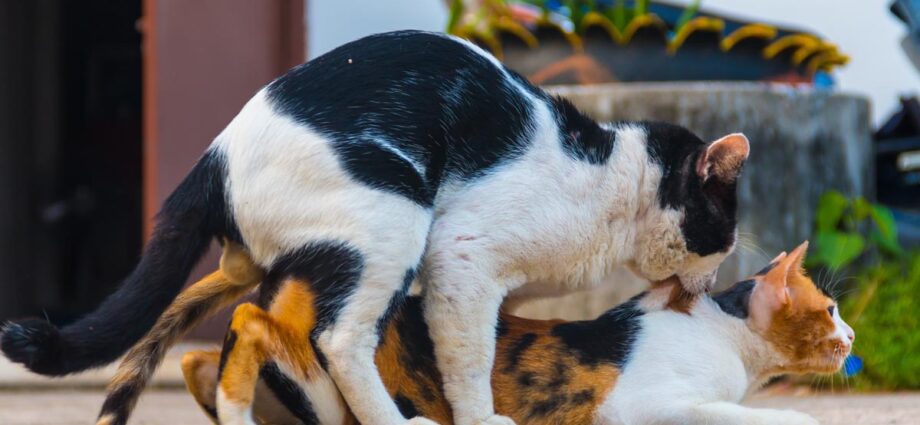Contents
Cat reproduction: all about cat mating
Reproduction in cats begins at puberty. If you want to mate your cat, it is necessary to know how its reproductive cycle works. In addition to individual variations, there are notable differences depending on the cat breeds. In any case, a visit to your veterinarian is essential so that he can give you personalized advice based on your animal.
Puberty in cats
Puberty corresponds to the period from which the cat, male or female, will be able to reproduce. In the cat, the first heat will then begin to appear. Usually, puberty takes place around 6 to 9 months of age. Its onset of appearance depends not only on the breed of the cat but also on the time of year it was born.
In fact, in cats of half-long to long-haired breeds, puberty generally appears later. In addition, a cat born in spring or autumn will have her first heat in the following winter / spring. The age of onset of puberty is therefore very variable and can range from 4 to 12 months or even more.
The estrus cycle in the cat
The time of year is an essential point to take into account if you want to mate your feline. Indeed, the cat is a species whose sexual cycles depend on the duration of the daylight. It is said to have “long days”, this means that its breeding season is generally from February to September / October in the countries of the northern hemisphere, months when the days are the longest. There is then no possibility of mating in winter, except in special cases. This period corresponds to what is called a “winter anestrus”. Note that sometimes some cats who live in an apartment can be in heat all year round.
It is also important to keep in mind that some breeds have phases of anestrus within their breeding season. These are periods during which mating is impossible although it is long days. This is the case, for example, of certain breeds of cats with medium to long hair which have anestrus in April / May and in July / August. If you have a purebred cat, it is therefore very important to learn about its peculiarities in order to know the periods of heat conducive to mating.
The heat is divided into 2 phases in the cat:
- proestrus;
- estrus.
Note that there is no flow of blood as in the bitch. Proestrus corresponds to a period of approximately 12 to 48 hours during which the behavior of the cat is identical to that of estrus but the cat refuses mating. Then comes estrus, lasting about 7 to 8 days, also more or less long depending on the breed.
For example, the Siamese have a longer estrus (around 12 days) while it is more reduced in the Persians (around 6 days). During estrus mating is possible. The behavior of the cat is manifested by meowing in a characteristic way, friction but also an elevation of the hindquarters. If there is no projection, heat follows one another during the breeding season. A cat is on average in heat 1 week out of 2 to 3 depending on the breed. This is the case for example of the Siamese, in heat about 1 week out of 2.
For more information on the peculiarities of each breed of cats, visit the LOOF website (Official Book of Feline Origins) https://www.loof.asso.fr or contact the breed clubs.
Mating in cats
It is coitus that will trigger ovulation in the cat. Without mating, the female will not ovulate, that is to say, release her oocytes. Nevertheless, several projections are necessary to trigger ovulation, on average 3 to 4 successive. It is therefore important to leave the male and the female for several hours together so that there are several projections. On the other hand, in rare cases, spontaneous ovulation can take place, that is to say without coitus. This is sometimes the case in certain elderly females living in catteries.
Likewise, ovulation does not mean systematic fertilization. If fertilization has taken place, then the gestation period begins. Otherwise, a phase of pseudogestation takes place. Ovulation did take place but fertilization did not. This phase lasts about a month after which a return to heat is possible.
Finally, since several matings are necessary for ovulation, if several males mate with the cat, it is possible that the kittens of the litter have a different father.
If you decide to breed your cat, male or female, it is important to discuss this beforehand with your veterinarian so that he can examine your animal and guide you on the procedure to follow. It is indeed important that your cat is in good health. In addition, it should be borne in mind that, in cats, sexually transmitted diseases exist. Finally, in some breeds, hereditary diseases can also be transmitted to future kittens.
Reproduction in older cats
Note that from around the age of 7, the cat has more irregular cycles. There is no menopause in the cat, or even in the bitch, the heat will therefore last until the end of its life but in a more irregular manner. Mating is still possible but the size of the litter can be reduced. In addition, certain problems related to gestation are more frequent such as abortions or dystocia (difficult deliveries).










